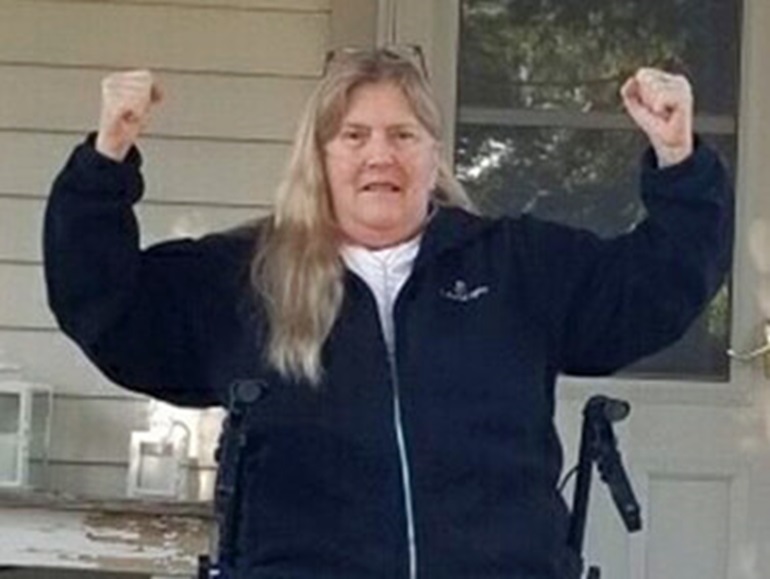Cyndy's Story

Celebrating victory over the virus
Cyndy Obe was an active 64-year-old wife, mother and grandmother who loved her job as a direct support professional for people with disabilities.
In April, as COVID-19 spread across the United States, Cyndy began experiencing symptoms like those described in news reports about the virus, including severe shortness of breath. She remained at home for a week, but when her breathing ability worsened, she called 911.
Rushed to the local hospital’s emergency room, Cyndy tested positive for the virus. She was admitted to the COVID-19 isolation unit and began receiving treatment to manage her symptoms and increase her strength.
A week later, however, Cyndy’s condition worsened. She was transferred to the COVID-19 intensive care unit and accepted into two clinical trials for potential treatment. Continuing to struggle, Cyndy was placed on a ventilator and breathing tube. She was sedated and turned prone (on her stomach) to improve lung function. Her body reeled from high fevers and low blood pressure, both of which required special medications.
The physicians and nurses in the ICU kept her family up to date, eventually suggesting they meet with the palliative care team to discuss whether to continue treatment.
Remarkably, she began to turn the corner. Over three weeks, Cyndy’s oxygen support needs decreased. By Memorial Day, she liberated from the ventilator. It was a huge victory, but Cyndy still needed high-flow supplemental oxygen. Due to prolonged sedation, she’d also developed ICU delirium, an intense confusion that can cause a person to become paranoid or lose touch with reality. She was severely debilitated after six weeks in bed.
Because of her complex needs, Cyndy was transferred to Select Specialty Hospital - South Dakota for additional healing and recovery time.
She arrived in early June, unable to sit up in bed without getting winded. She needed a feeding tube because she was too weak to swallow.
After weeks of fighting for her life, Cyndy’s goals were simple – she wanted to be able to live at home and see her children and grandchildren again.
A physician-led team of therapists, nurses and dietitians created a plan to help Cyndy get there.
Respiratory therapists began slowly reducing her supplemental oxygen, giving her body time to adjust and build stamina. They worked on breathing, coughing and chest exercises to increase lung capacity, hoping to move Cyndy’s oxygen needs to a lower flow that could more easily be managed at home.
Nurses checked on Cyndy frequently, encouraging her to continue working hard each day. They monitored her vital signs, medications and skin for signs of breakdown.
Occupational and physical therapists started with smaller movements, such as opening and closing her hand to improve dexterity and sitting at the bed’s edge to retrain core muscles. In time, they progressed from sitting to standing to walking with a walker, climbing stairs and traveling to the bathroom for a shower.
Cyndy’s most important and meaningful task was working with her speech therapist on swallowing, so that she resume eating real food. Each weekday, they practiced jaw, tongue and throat exercises to allow her to eat safely. She passed a swallow study that indicated she was not at risk of drawing food or liquid into her lungs. Dietitians created a meal plan to transition her back to eating by mouth – pureed foods at first, then larger pieces.
After a month at Select Specialty Hospital, Cyndy’s oxygen levels had improved and her feeding tube was removed. In spite of long odds, she was ready to go home. She still needed help moving about without tiring, but she’d met about 85% of her goals and felt ready to propel herself the rest of the way.
On the day of her discharge, Cyndy’s husband, children, grandchildren and church family gathered at a socially responsible distance outside the hospital to cheer her on as she got into the car. Now back at home, she intends to work hard to increase her strength and continue on her path to a full recovery.